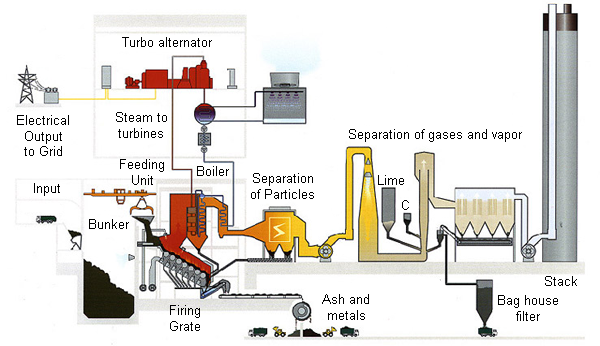History
Municipal solid waste incinerators (MSW) have come a long way. The past incinerators were extremely hazardous for both the workers and the environment. Now under controlled conditions and with the increase in garbage, incinerators have become the methods of choice in many municipalities. Some of the first plants date back to the 1880s when there was little regulation. It took till the 1960s for governments to finally write out laws and the 1990s for them to start using methods to recycle energy. Much has changed to regulate and sustain incineration plants.Methods
One of the first MSW incineration techniques was a batch style, which incorporated burning trash in heaps at a time. As technologies increased, methods have gone from batch style, to stationary hearth, to continuous feeding. Three of the most common incineration methods today are mass burning, refuse derived fuel systems, and modular systems. Mass burning is the most common. This involves a single combustion chamber which is filled with large amounts of waste. The trash is then burned down at temperatures as high as 2000 degrees Fahrenheit. The remaining ash is then transported to a nearby landfill. Refuse derived fuel systems sort combustive materials from non-combustive materials. The sorted waste is then processed into usable furnace and boiler fuel. Modular systems operate with a much smaller amount of waste at a time. They use an unprocessed mix of MSW allowing it to be faster and more portable. This style of incineration can be easily moved from site to site. With these new methods of burning waste, incinerators are now also recycling energy. When the chambers heat up, large amounts of steam is released. The steam is then funneled into a turbine, resulting in energy!
Incineration process. Image source:WtERT
Communal Advantages and Disadvantages
Municipal solid waste incinerators have both positive and negative effects to communities. One positive is they are extremely efficient with reducing waste from landfills. 95%-96% of the trash gets burned down to ash. It also is the best alternative to reducing methane emissions and as a by-product creates energy. Lastly, these plants can be made close to populations, reducing transportation expenses. The negative side is that these plants are wildly expensive. Running a plant requires expensive materials, operating costs and skilled personnel. Due to this, most plants are not found in developing countries. Another issue is that incinerating materials means loss of resources. It takes a large amount of effort to reconstruct these resources with possible harm to the environment.Emissions Monitoring
Most MSW incinerators will be outfitted with continuous emissions monitoring systems or CEM’s. Detailed, real time emissions data allows government regulators to ensure the facility is operating within pre-determined emissions guidelines and provides the owner with information critical to maintaining optimal operations. In addition, MSW incinerators are required to sample manually for a multitude of potential pollutants. Namely, these parameters are particulate matter, dioxin/furans, trace/heavy metals, ammonia, sulphur oxides, hydrogen chloride and hydrogen fluoride, among others.- Lanfranco and Associates Inc. is equipped with state of the art equipment capable of monitoring all the possible permitted contaminants including 3 mobile CEM units for Relative Accuracy Test Audits (RATA’s).

